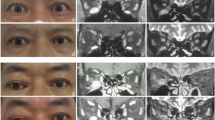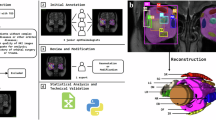Abstract
Purpose To assess the correlation between inflammatory activity in extraocular muscles measured with serial short tau inversion recovery (STIR) sequence magnetic resonance imaging (MRI) scans and clinical disease activity in thyroid eye disease.
Methods In this retrospective study, 22 patients with thyroid eye disease who had undergone serial MRI scans using the STIR sequence were assessed. The signal intensity ratio (SIR) of the most inflamed extraocular muscle was compared with the Mourits score (a clinical measure of thyroid eye disease activity).
Results The SIR value has previously been shown to correlate with clinical activity of thyroid eye disease. In a particular patient the SIR value increases in proportion with the clinical features of the disease as assessed by the Mourits rating system. When the change in STIR sequence MRI is compared with the change in Mourits score rating for a given patient the correlation is highly significant (p < 0.001).
Conclusions This study confirms that serial STIR sequence MRI scans correlate with clinical disease activity. Inflammatory activity in the most inflamed muscle (as measured by SIR) reflects overall disease activity. SIR values obtained from MRI scans provide a useful measure of disease activity and may help in the monitoring and treatment of this condition.
Similar content being viewed by others
Log in or create a free account to read this content
Gain free access to this article, as well as selected content from this journal and more on nature.com
or
References
Steel DHW, Potts MJ . Thyroid eye disease. In: Sparrow JM, Easty DL, editors. Oxford textbook of ophthalmology. Oxford: Oxford University Press, 1999:722–30.
Bahn RS, Heufelder AE . Pathogenesis of Graves' ophthalmology. N Engl J Med 1993;329:1468–75.
Rundle FF, Wilson CW . Development and course of exophthalmos and ophthalmoplegia in Graves' disease with special reference to the effect of thyroidectomy. Clin Sci 1945;5:177–94.
Mourits MPH, Koorneef L, Wiersinga WM, Prummel MF, Berghant A, Gaag RVD . Clinical criteria for the assessment of disease activity in Graves' ophthalmopathy: a novel approach. Br J Ophthalmol 1989;73:639–44.
Prummell MF, Mourits MP, Berghout A, Krenning EP, van der Gaag R, Koornneef L, et al. Prednisolone and cyclosporine in the treatment of severe Graves' ophthalmopathy. N Engl J Med 1989;321:1353–9.
Werner SC . Classification of the eye changes of Graves' disease. J Clin Endocrinol Metab 1969;29:982–4.
Werner SC . Modification of the classification of the eye changes of Graves' disease. Am J Ophthalmol 1977;83:725–7.
Hallin ES, Feldon SE . Graves' ophthalmopathy. II. Correlation of clinical signs with measures derived from computed tomography. Br J Ophthalmol 1988;72:678–82.
Hosten N, Sander B, Cordes M, Schubert CJ, Schörner W, Felix R . Graves' ophthalmopathy: MR imaging of the orbits. Radiology 1989;172:759–62.
Just M, Kahaly G, Higer HP, Rösier HP, Kutzner J, et al. Graves' ophthalmopathy: role of MR imaging in radiation therapy. Radiology 1991;179:187–90.
Hoh HB, Laitt RD, Wakely C, Kabala J, Goddard P, Potts MJ, et al. The STIR sequence MRI in the assessment of extraocular muscles in thyroid eye disease. Eye 1994;8:506–10.
Laitt RD, Hoh B, Wakeley C, Kabala J, Harrad R, Potts MJ, Goddard P . The value of the short tau inversion recovery sequence in magnetic resonance imaging of thyroid eye disease. Br J Radiol 1994;67:244–7.
Claridge KG, Ghabrial R, Davis G, Tomlinson M, Goodman S, Harrad RA, et al. Combined radiotherapy and immunosuppression in the management of thyroid eye disease. Eye 1997;11:717–22.
Hurbli T, Char DH, Harris J, Weaver K, Greenspan F, Sheline G . Radiation therapy for thyroid eye diseases. Am J Ophthalmol 1985;99:633–7.
Feldon SE, Muramatsu S, Weiner JM . Clinical classification of Graves' ophthalmopathy. Arch Ophthalmol 1984;102:1469–72.
Steel DHW, Hoh HB, Potts MJ, Harrad RA . Uniocular fields of fixation in thyroid eye disease. Eye 1995;9:348–51.
Author information
Authors and Affiliations
Rights and permissions
About this article
Cite this article
Mayer, E., Herdman, G., Burnett, C. et al. Serial STIR magnetic resonance imaging correlates with clinical score of activity in thyroid eye disease. Eye 15, 313–318 (2001). https://doi.org/10.1038/eye.2001.102
Received:
Accepted:
Issue date:
DOI: https://doi.org/10.1038/eye.2001.102
Keywords
This article is cited by
-
Quantitative assessment of extraocular muscles in Graves’ ophthalmopathy using T1 mapping
European Radiology (2023)
-
Extraocular muscle enlargement
Graefe's Archive for Clinical and Experimental Ophthalmology (2022)
-
Quantitative evaluation of activity of thyroid-associated Ophthalmopathy using short-tau inversion recovery (STIR) sequence
BMC Endocrine Disorders (2021)
-
T2-relaxation mapping and fat fraction assessment to objectively quantify clinical activity in thyroid eye disease: an initial feasibility study
Eye (2019)
-
Quantitative Analysis of Inflammation in Orbital Fat of Thyroid-associated Ophthalmopathy Using MRI Signal Intensity
Scientific Reports (2017)



